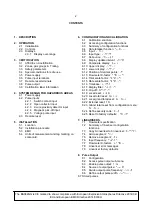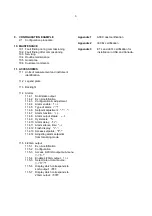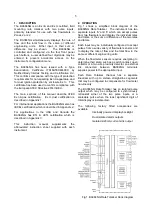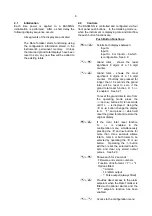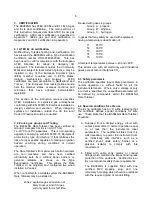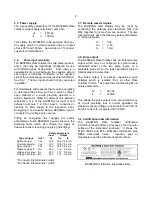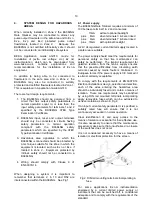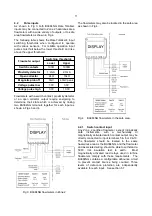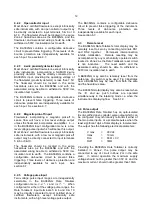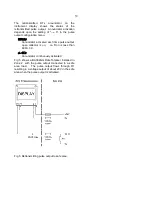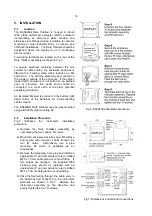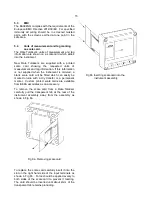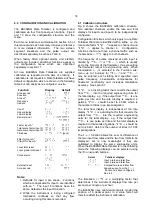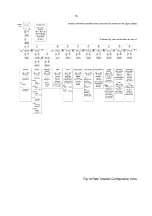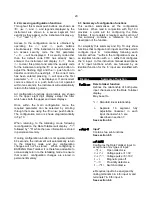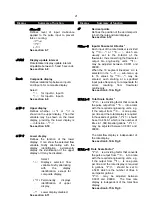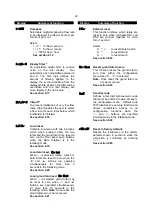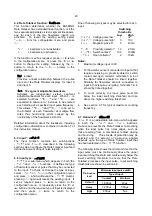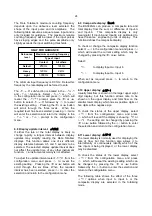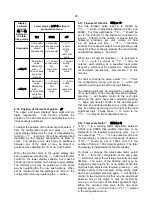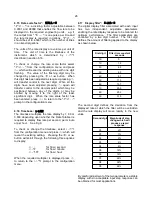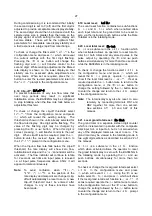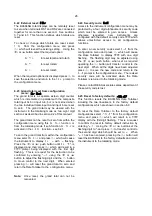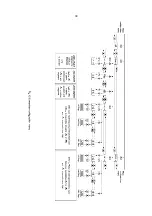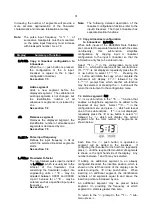
16
6.0 CONFIGURATION AND CALIBRATION
The BA384NG Rate Totaliser is configured and
calibrated via four front panel push buttons. Figs 9
and 10 show the configuration structure and the
menu.
Each menu function is summarised in section 6.3 of
this manual and each summary includes a reference
to more detailed information. The two sixteen
segment linearisers and the pulse output are
described separately in sections 7 and 8.
When factory fitted optional alarms and 4/20mA
outputs are included, additional functions appear in
the configuration menu which are described
separately in section 11.
All new BA384NG Rate Totalisers are supplied
calibrated as requested at the time of ordering. If
calibration is not requested, Rate Totalisers will have
default configuration which is shown in the following
table, but can easily be re-configured on-site.
Function
Display Default
Access code
CodE
0000
Function
FunCtion
5td
A Input*
inP
.
tYPE-A
oP.CoL
Debounce
dEbounCE
dEFAuLt
Update
uPdAtE
0
.
5
Count
Count
A
:
b
Upper display
di5p-1
totAL
Lower display
di5P-2
5td
Decimal point
dP
Total00000000
Rate 0000.0
Factor input A*
FACtor-A
001
.
00
Total scale factor input A*
5cALE
.
T-A
001
.
00
Rate scale factor input A*
5cALE
.
R-A
001
.
00
Timebase
t-bA5E
tb-01
(secs)
Filter for input A*
FiLter-A
24
Clip-off for input A*
CLP
.
oFF-A
0000.0
Local total reset
Clr tot
oFF
Local grand total reset
Clr Gtot
oFF
Pulse source
5ource
5caled
divide
1
duration
0
.1
External reset
E clr
clr anb
Access code
CodE
0000
Notes:
1. Defaults for input A are shown. Functions
which are duplicated for input b are identified
with an
*.
The input b functions have the
same default as the input A function.
2. While the instrument is being configured
totalisation continues so that any flow
occurring during this time is recorded.
6.1 Calibration structure
Fig 9 shows the BA384NG calibration structure.
Two identical channels enable the rate and total
displays for input A and input b to be independently
configured.
Configuration functions which only apply to one Rate
Totalisier channel are identified with a suffix, i.e. the
rate scale factor
5CALE
.
r-A
applies to channel A and
5CALE
.
R-b
applies to channel b. Configuration
functions that do not have a channel suffix, such as
the timebase
t-bA5E
, apply to both channels.
The frequency of pulses received at each input is
divided by
FACtor-A
or
FACtor-b
, which is usually
set to the K-factor of the flowmeter, thus converting
the flowmeter output into engineering units. When
linearisation
Lin
is selected in the Function sub-
menu, up to 16 values for
FACtor-A
and
FACtor-b
may be entered, each starting at a specified input
pulse frequency. Linearisation compensates for
flowmeter nonlinearity and increases totalisation
accuracy. See section 7.
5CALE-r
is a dividing factor that converts the output
from
FACtor
into the required engineering units for
the rate display. e.g. if the output from
FACtor
is one
pulse per litre and the rate display is required in
gallons,
5CALE-r
should be set to 4.5461 which is
the number of litres in an imperial gallon.
The total flow display is independent of the rate
display.
5CALE-t
is a dividing factor that converts the
output from
FACtor
into the required engineering
units for the total display. e.g. if the output from
FACtor
is one pulse per litre and the total display is
required in thousands of gallons,
5CALE-t
should be
set to 4,546.1 which is the number of litres in 1,000
imperial gallons.
The
Count
function allows the sum or difference of
the two input flow rates and the two flow totals to be
displayed, but is only meaningful if they are
calibrated to display the same engineering units.
When the BA384NG Rate Totaliser is in the totalising
mode the following displays can be selected using
the
&
or
*
push buttons:
Select Totaliser displays
Input A
Input A rate and total flow
Input b
Input b rate and total flow
A
:
b or A
:
-b
Composite rate and total flow
depends upon how the
Count
function has been configured
See 6.9
The timebase
t-bA5E
is a multiplying factor that
determines if the instrument displays flow rate per
second, per minute or per hour.
The BA384NG uses ‘real’ decimal points, moving the
position of a decimal point in a scale factor will
therefore affect the instrument calibration.

